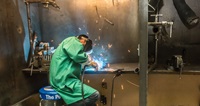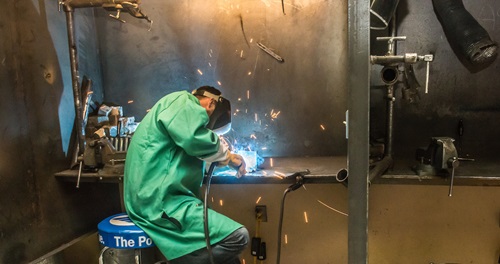
Take the first step towards a career in the hydroelectric industry by applying for DWR’s Operations and Maintenance apprenticeship program. Completing the program leads to a full-time journey-level position with DWR.

Mechanical apprentice practices welding at the DWR Operations and Maintenance Training Center. DWR/2016.
The Department of Water Resources (DWR) offers a paid apprenticeship program that can lead to a fulfilling and lucrative career in the hydroelectric industry. The program combines hands-on-learning, classroom instruction, and home study with supervised on-the-job training.
The program takes three to four years to complete, depending on the trade specialization. Participants progress through the program upon successfully completing each six-month period and advancing to a range increase in pay. After participants have successfully completed the program, they become certified as a journey person and guaranteed full time employment with DWR.
Application periods are typically in the spring. Check back here for current information.
Apprenticeship Program Qualifications
Applicants must:
Knowledge and Abilities:
The Apprenticeship Program Exam and Hiring Timeline
Prior to being considered for the apprenticeship program, candidates must pass a DWR apprenticeship civil service examination, given each year. This examination includes a written section that covers math (fractions, ratios, percentages, square roots, and algebra), reading and comprehension, and mechanical aptitude. Candidates who do not pass the examination may retake it the following year.
The examination and hiring process for the DWR Apprenticeship Program takes place once a year and is a 3-step process.
Candidates selected from the interviews process for the Apprenticeship Program, will be notified and given a tentative offer and will complete new hire documents mid-October. Then selected candidates will begin the Apprenticeship Program the beginning of January.
*Dates subject to possible change.
Apprenticeship training in California originated with the passage of the Shelley-Maloney Apprentice Labor Standards act of 1939.
Apprenticeship training is a formal organized system of on-the-job training in which the apprentice learns by doing, and earns while learning. It is based upon a written agreement, called an indenture, between the employer and the apprentice. This agreement spells out how long the apprenticeship training lasts, what kinds of job tasks (called "work processes hours") are to be performed while working on-the-job, and what kinds of subject matter and work related knowledge must be learned through a program of home study and classroom instruction.
The duration of apprenticeship training varies from trade to trade. In the California Department of Water Resources, the periods of apprenticeship training are as follows:
The term of apprenticeship is divided up into six-month periods. At the end of each six-month period, on-the-job work and classroom/home study progress is evaluated by the apprentice’s supervisors and recommendation made to a Joint Apprenticeship Committee (JAC) which approves or disapproves advancement to the next six-months level of training and salary.
After candidates have successfully passed the examination process and have been hired as apprentices - either operator, electrician, mechanic or utility craftsworker - they are assigned to work under close observation of a fully qualified and knowledgeable worker who has completed apprenticeship training and has been certified by the State of California as a journey-person.
During the first year of training, apprentices will receive detailed instructions on-the-job, attend several weeks of classroom instructions in technical subject matter and complete approximately 100-150 hours of home study courses. In the second year, apprentices will continue to receive classroom instruction, on-the-job instruction, and work under the supervision of a journey-level worker but will perform some tasks with minimum supervision. In succeeding years, apprentices will perform more and more complex tasks, demonstrating the knowledge and abilities required on-the-job. When the term of apprenticeship training has been successfully completed and all requirements have been met, the employer (Department of Water Resources), certifies the information to the Department of Industrial Relations, and the apprentice is issued a certificate and is guaranteed to be employed as a journey-person.
The position of Apprentice is an opportunity to learn the trades and craft from qualified journey-persons. Apprentice training within the Department of Water Resources is of a highly intensive technical nature and is comprised of the following interrelated elements:
On-The-Job-Training
This is the actual day-to-day hands-on work in which the apprentice "learns by doing." Generally, 1820 hours of on-the-job experience per year. A hands-on proficiency test is given every six-months to check and verify that the apprentice is gaining applicable and measurable experience.
Classroom Training
The Department of Water Resources Joint Apprenticeship Committee has established classroom courses in which a variety of classes are taught during regular working hours at Department facilities. Subject matter ranges from Math Review to the Theory of System Operation. The number of hours of classroom training required each year is different for each apprentice trade. Usually, the classes are 40 hours in duration or one work week. A test is given at the end of each class.
Home Study
As the name implies, there is a substantial program of study that is to be completed away from the job site at the apprentice’s home. It will be essential to establish a regular time and place to study and do a certain amount of the related training (home study). At the completion of each unit of home study a written test is given on the material covered in that particular unit.
Every six-months, a closed book examination is given, all the home study material covered for that particular six-month period, will be subject to testing.
All exams must be passed with a minimum score of 70%; three failures of the same exam will result in termination of the Apprentice Agreement .
All three of these training phases: on-the-job, classroom, and home study; are integrated so that each reinforces the other. Each element is just as important as the other.
Once you have passed the apprentice exam and interview process and have been hired into a position, your period as an apprentice begins. The following trades are offered:
Utility Craftsworker Apprentice ($4358 - $6034) - Learn progressively skilled work in the repair, operation, modification, inspection, replacement and maintenance of major civil structures and related utility equipment associated with the State Water Project or the Sacramento River Flood Control Project.
Hydroelectric Plant Operator Apprentice ($4470 - $6909) - Assist a journeyperson operator and receive training in performing either manual or remote-control water and power operating and switching. Learn to: follow safe operating and clearance procedures; make routine inspections of generating and pumping units, auxiliaries and switchyard equipment; record readings of meter gauges and indicators and make logbook entries; detect any abnormal readings, sounds, smells or other indications of trouble; check local and remote recording instruments and adjust pens, charts and tape as necessary; prepare routine daily and monthly reports.
Hydroelectric Plant Electrician Apprentice ($4470 - $7315) - Assist a journeyperson electrician and receive training in the installation, repair and maintenance of wiring circuits for electrical equipment, motors and control devices. Learn to: disassemble, repair and reassemble motors, generators, large transformers, oil and air circuit breakers, disconnect switches, voltage regulators, power switchboard and other electrical equipment; test and service storage batteries; install conduits, pull wire and control board wiring; diagnose and troubleshoot electrical problems under emergency conditions.
Hydroelectric Plant Mechanic Apprentice ($4470 - $7315) - Assist a journeyperson mechanic and receive training in the repair, disassembly and assembly of large and complex equipment such as piping systems, gear boxes, drive mechanisms, pumps, turbines, motors, generators, compressors, hydraulic power and pressure units, refrigeration and air conditioning systems, valves, gates and trash racks. Learn to: test, adjust, service and maintain various mechanical meters and gates used in measuring capacity, flow pressure, temperature and velocity of liquids and/or gases; perform welding, burning, cutting and grinding; operate large overhead cranes and perform rigging.
Recommend Study Material:

Take the first step towards a career in the hydroelectric industry by applying for DWR’s Operations and Maintenance apprenticeship program. Completing the program leads to a full-time journey-level position with DWR.